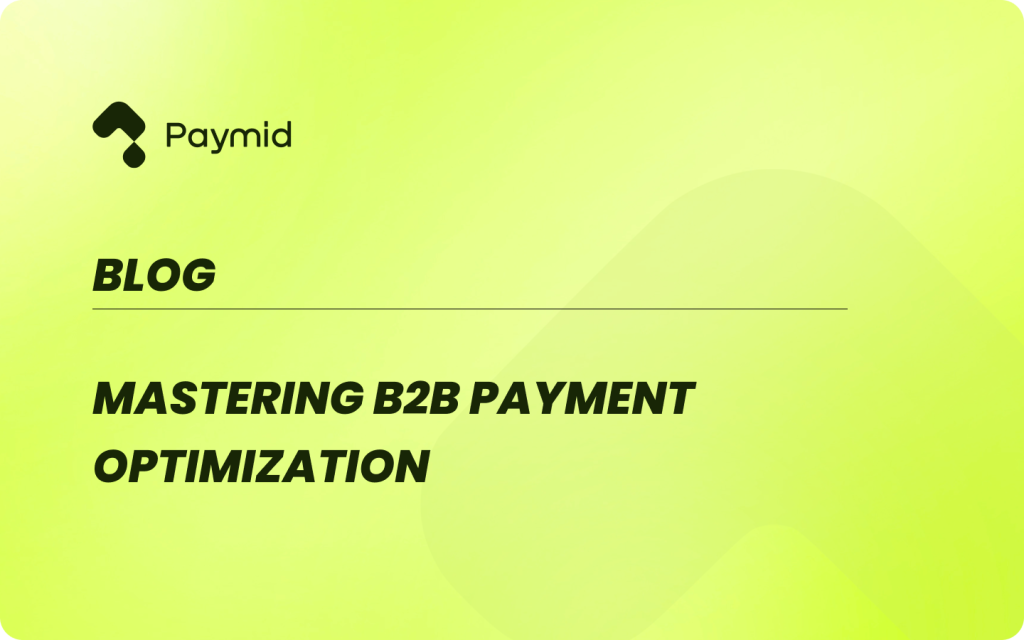Mastering B2B Payment Optimization [Expert Tips]

Inefficient payment processes cost businesses billions of dollars annually in lost revenue and operational inefficiencies[1]. As organizations navigate increasingly complex financial landscapes, B2B payment optimization has become crucial for maintaining competitive advantage and ensuring healthy cash flow. Modern businesses face numerous challenges in their payment operations, from manual processing delays to a lack of payment visibility and reconciliation issues.
The evolution of B2B payment solutions has created new opportunities for organizations to streamline their payment workflows and reduce operational costs. Through the strategic implementation of B2B digital payments and advanced payment processing systems, companies can transform their financial operations while maintaining security and compliance standards[2].
The global B2B e-commerce market, valued at USD 7.08 trillion in 2022, is projected to reach USD 26.59 trillion by 2030, highlighting the critical importance of efficient payment systems in modern business operations[3]. This explosive growth has transformed B2B payments from a routine back-office function into a strategic business imperative. Organizations face several critical obstacles in their payment operations that impact efficiency and profitability. Processing costs remain a significant concern, with 35% of businesses reporting high costs as a major challenge. The average cost to process a single supplier payment approaches USD 8.00, with 62% attributed to labour expenses[4]. Key challenges include: The inefficiencies in B2B payment processes directly affect working capital management. Nearly 55% of middle market players struggle to maintain sufficient working capital, while the average U.S. business using paper-based processes has approximately 24% of its working capital tied up in net terms. Payment delays compound this issue, with an average processing time of 30 days and 47% of suppliers experiencing late payments[5]. Successful B2B payment optimization requires careful monitoring of specific performance metrics. Payment conversion rate serves as the fundamental indicator of system efficiency, while bank approval rates help identify potential processing bottlenecks. Organizations should focus on: Transaction Success Metrics: Modern payment solutions emphasize real-time monitoring capabilities, enabling businesses to track these metrics continuously and make data-driven decisions for optimization[6]. The integration of artificial intelligence and automated systems has made it possible to analyze these KPIs more effectively, leading to improved payment processing efficiency and reduced operational costs. Developing an effective B2B payment optimization strategy requires a systematic approach that aligns with organizational objectives while addressing existing challenges. Organizations must carefully evaluate their current capabilities before implementing new payment solutions. A thorough analysis of existing payment systems forms the foundation for optimization efforts. Organizations should evaluate their payment processing capabilities, including transaction volumes, processing times, and integration points with other financial systems. This assessment should identify key bottlenecks and inefficiencies in current workflows, particularly areas where manual intervention creates delays or increases error risks[7]. Strategic objectives should focus on measurable improvements in payment operations. Key optimization targets typically include: The implementation roadmap should outline a phased approach to payment optimization. Organizations must prioritize initiatives based on potential impact and resource requirements. Integration planning becomes crucial, ensuring new payment solutions work seamlessly with existing ERP and accounting systems[8]. The roadmap should include clear milestones for: Success depends on establishing clear metrics for measuring progress and maintaining flexibility to adapt to changing business needs. Organizations should consider working with payment consultants who can provide expertise in implementation best practices and help negotiate better rates with processors. Digital transformation in B2B payments represents a critical shift from traditional processing methods to modern, automated solutions. Organizations must carefully navigate this transition to ensure successful implementation while maintaining operational continuity[9]. The selection of appropriate payment technologies forms the cornerstone of successful digital transformation. Organizations should evaluate potential solutions based on: Successful integration requires careful consideration of existing infrastructure and potential compatibility challenges[10]. Organizations should focus on seamless connectivity between new payment solutions and current Enterprise Resource Planning (ERP) systems, accounting software, and other financial platforms. Integration success depends on: The human element plays a crucial role in digital transformation success. Organizations must address resistance to change through effective communication and training programs[11]. Key considerations include: Success in B2B payment optimization relies heavily on establishing robust measurement frameworks and leveraging data-driven insights. Organizations must implement comprehensive monitoring systems to track performance and identify opportunities for enhancement. Successful payment optimization requires monitoring specific metrics that directly impact financial operations. Organizations should focus on these critical indicators: Advanced analytics capabilities transform raw payment data into actionable intelligence. Real-time visibility into transaction patterns enables organizations to make informed decisions about their payment processes[13]. Edge computing and AI-driven analytics provide immediate insights into transaction bottlenecks, helping businesses identify and address inefficiencies promptly. The implementation of predictive analytics allows organizations to forecast payment trends and anticipate potential issues before they impact operations. By analyzing historical payment data, businesses can optimize their payment acceptance strategies and improve cash flow management. Organizations must establish a systematic approach to ongoing optimization. This involves regular review cycles and performance assessments to ensure payment systems remain efficient and effective. Key components of a successful improvement framework include: The framework should emphasize the integration of feedback loops that enable quick responses to changing market conditions and emerging payment technologies. Organizations must maintain flexibility in their approach while ensuring compliance with evolving regulatory requirements and security standards[14]. By leveraging advanced data analytics and maintaining a robust measurement framework, organizations can continuously enhance their B2B payment processes, leading to improved operational efficiency and stronger financial performance. Read More: B2B payment optimization stands as a critical driver of business success in today’s digital economy. This comprehensive examination has highlighted essential strategies for transforming payment operations through strategic planning, digital adoption, and data-driven optimization. Organizations that master B2B payment optimization gain significant advantages: Modern businesses must recognize that payment optimization extends beyond mere cost reduction. Data shows that companies implementing comprehensive payment strategies achieve up to 80% reduction in processing times and 65% decrease in transaction costs. The path forward demands careful attention to technology selection, system integration, and change management. Success relies on establishing clear metrics, maintaining robust measurement frameworks, and committing to continuous improvement through data analytics. Organizations embracing these strategies position themselves for sustained growth and operational excellence in an increasingly complex business environment. Their enhanced payment capabilities become a strategic asset, supporting broader business objectives while ensuring long-term financial health and competitive advantage.
Understanding B2B Payment Landscape
Current Challenges in B2B Payments
Impact on Working Capital
Key Performance Indicators for Payment Optimization
Developing a Payment Strategy
Assessing Current Payment Infrastructure
Setting Optimization Goals
Creating Implementation Roadmap
Implementing Digital Transformation
Selecting Payment Technologies
Integration with Existing Systems
Change Management Considerations
Measuring and Optimizing Results
Key Performance Metrics
Data Analytics for Payment Optimization
Continuous Improvement Framework
Summary
References
[1] – LinkedIn – Hidden Inefficiencies Unveiling Cost Manual Processes. https://www.linkedin.com/pulse/hidden-inefficiencies-unveiling-cost-manual-processes-ripla-pgcert-vksne

